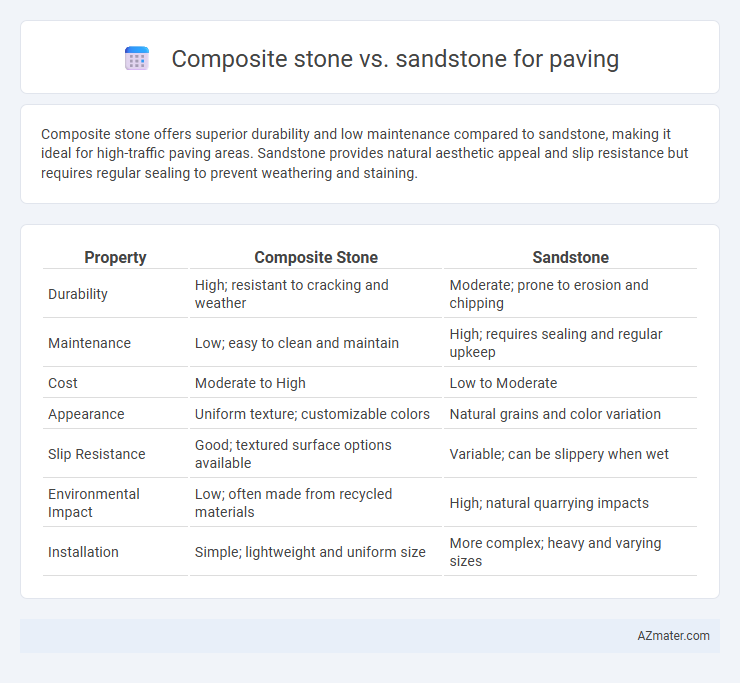Composite stone offers superior durability and low maintenance compared to sandstone, making it ideal for high-traffic paving areas. Sandstone provides natural aesthetic appeal and slip resistance but requires regular sealing to prevent weathering and staining.
Table of Comparison
| Property | Composite Stone | Sandstone |
|---|---|---|
| Durability | High; resistant to cracking and weather | Moderate; prone to erosion and chipping |
| Maintenance | Low; easy to clean and maintain | High; requires sealing and regular upkeep |
| Cost | Moderate to High | Low to Moderate |
| Appearance | Uniform texture; customizable colors | Natural grains and color variation |
| Slip Resistance | Good; textured surface options available | Variable; can be slippery when wet |
| Environmental Impact | Low; often made from recycled materials | High; natural quarrying impacts |
| Installation | Simple; lightweight and uniform size | More complex; heavy and varying sizes |
Introduction to Composite Stone and Sandstone
Composite stone combines natural stone fragments with resins and pigments, offering durability, uniformity, and resistance to weathering, making it ideal for high-traffic paving areas. Sandstone, a sedimentary rock composed mainly of quartz and feldspar, provides natural texture and earthy tones, valued for its aesthetic appeal and slip resistance in outdoor paving. Both materials present unique advantages, with composite stone excelling in strength and maintenance, while sandstone offers authentic natural beauty and a timeless appearance.
Composition and Manufacturing Process
Composite stone for paving typically consists of natural stone aggregates bound with resin or cement, creating a durable and uniform material through a casting or pressing process. Sandstone, a natural sedimentary rock primarily composed of quartz and feldspar, is quarried and cut directly from stone deposits without additional binding agents. The manufacturing of composite stone allows for enhanced strength and customization, while sandstone relies on its inherent geological composition and natural weathering properties.
Aesthetic Variety and Design Options
Composite stone offers a broader aesthetic variety and more customizable design options compared to sandstone, featuring engineered colors, textures, and patterns that can mimic natural stone or provide unique finishes. Sandstone provides natural, earthy tones with subtle variations, appealing to those seeking organic and timeless paving designs but with limited color range. The versatility of composite stone allows for intricate layouts and consistent appearance, making it ideal for contemporary and diverse architectural styles.
Durability and Longevity Comparison
Composite stone offers superior durability compared to sandstone, as it is engineered to resist cracking, chipping, and weathering over time. Sandstone, a natural sedimentary rock, tends to be more porous and susceptible to erosion, making it less resilient in harsh climates. The longevity of composite stone paving significantly exceeds that of sandstone, often lasting decades longer with minimal maintenance.
Weather and Slip Resistance
Composite stone offers superior weather resistance compared to sandstone, maintaining structural integrity and color vibrancy under extreme temperatures and heavy rainfall. Its engineered surface provides enhanced slip resistance, reducing the risk of accidents in wet or icy conditions. Sandstone, while naturally attractive, tends to absorb moisture, which can lead to surface erosion and increased slipperiness over time.
Installation and Maintenance Requirements
Composite stone paving offers easier installation due to its lightweight nature and uniform shape, reducing labor time compared to traditional sandstone. Sandstone requires careful handling and skilled labor because of its natural irregularities and fragility during installation to avoid breakage. Maintenance for composite stone is generally low with high resistance to stains and weathering, while sandstone demands regular sealing and cleaning to preserve its appearance and prevent erosion.
Environmental Impact and Sustainability
Composite stone for paving offers enhanced sustainability through its use of recycled materials and lower energy consumption in manufacturing compared to natural sandstone, which involves quarrying that disrupts ecosystems and generates significant carbon emissions. Sandstone is a natural, biodegradable material but its extraction often leads to habitat destruction, soil erosion, and resource depletion. Selecting composite stone reduces environmental impact by minimizing waste and conserving natural stone reserves, supporting eco-friendly landscaping and sustainable construction practices.
Cost Analysis and Value for Money
Composite stone offers a higher upfront cost compared to sandstone but provides greater durability and lower maintenance expenses, resulting in better long-term value for paved surfaces. Sandstone is generally more affordable initially, but its susceptibility to weathering and higher maintenance can increase overall costs over time. Evaluating life-cycle cost analysis reveals composite stone as a more cost-effective choice for paving projects prioritizing longevity and minimal upkeep.
Ideal Applications and Use Cases
Composite stone offers superior durability and resistance to weathering, making it ideal for high-traffic patios, walkways, and commercial paving where longevity and low maintenance are crucial. Sandstone provides natural aesthetic appeal with its unique textures and earthy tones, suited for decorative garden paths, residential driveways, and outdoor seating areas requiring a softer, rustic look. Both materials complement different design goals: composite stone excels in functional, heavy-use environments, while sandstone enhances natural, visually appealing landscapes.
Conclusion: Choosing the Right Material for Your Paving
Composite stone offers superior durability, low maintenance, and versatile design options, making it ideal for high-traffic paving areas. Sandstone provides a natural aesthetic with unique textures and warmth, suitable for decorative or low-traffic spaces. Choosing the right material depends on balancing durability needs, visual preferences, and budget constraints for optimal paving performance.

Infographic: Composite stone vs Sandstone for Paving
 azmater.com
azmater.com